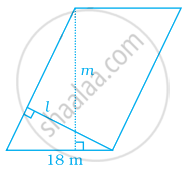Advertisements
Advertisements
प्रश्न
The adjacent sides of a parallelogram are 21 cm and 28 cm. If it's one diagonal is 35 cm; find the area of the parallelogram.
उत्तर
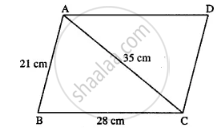
First, we find the area of ΔABC.
Sides are, a = 28 cm
b = 35 cm
and c = 21 cm
S = `(a + b + c)/2`
= `(28 + 35 + 21)/2`
= `84/2 = 42` cm
area of ΔABD = `sqrt(S(S - a)(S - b)(S - c))`
= `sqrt(42(42 - 28)(42 - 35)(42 - 21))`
= `sqrt(42 xx 14 xx 7 xx 21)`
= `sqrt(2 xx 21 xx 2 xx 7 xx 7 xx 21)`
= `sqrt(2 xx 2 xx 21 xx 21 xx 7 xx 7)`
= `2 xx 21 xx 7`
= 294 cm2
∵ Diagonal of ||gm divides it into two equal parts.
∴ area of ||gm = `2 xx "area of ΔABC"`
= 2 × 294
= 588 cm2
APPEARS IN
संबंधित प्रश्न
Find the area of the following parallelogram:
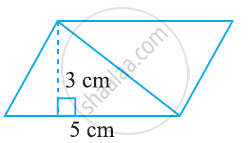
Find the area of the following parallelogram:

Find the area of the following parallelogram:
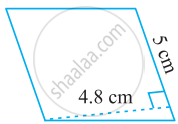
PQRS is a parallelogram (see the given figure). QM is the height from Q to SR and QN is the height from Q to PS. If SR = 12 cm and QM = 7.6 cm. Find:
- the area of the parallelogram PQRS
- QN, if PS = 8 cm

If area of a parallelogram is 29.6 sq cm and its base is 8 cm, find its height.
The area of parallelogram whose base 10 m and height 7 m is
In a parallelogram the base is three times its height. If the height is 8 cm then the area is
Find the area of the parallelogram ABCD if AC is 24 cm and BE = DF = 8 cm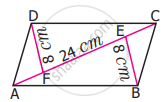
Area of parallelogram ABCD (see the figure) is not equal to ______.
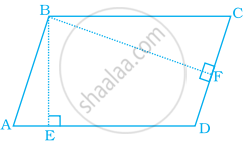
Perimeter of a parallelogram shaped land is 96 m and its area is 270 square metres. If one of the sides of this parallelogram is 18 m, find the length of the other side. Also, find the lengths of altitudes l and m in the given figure.
